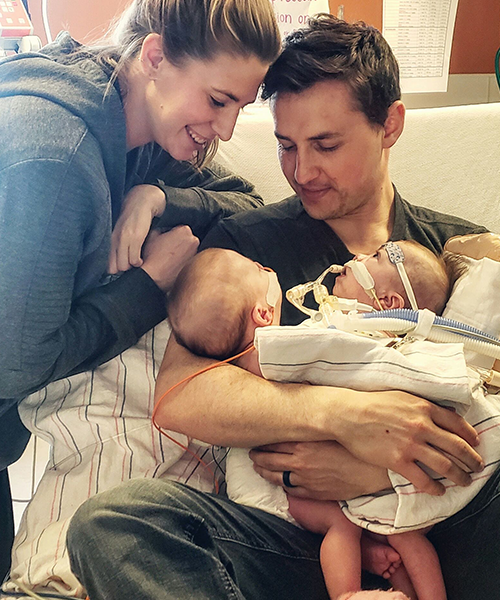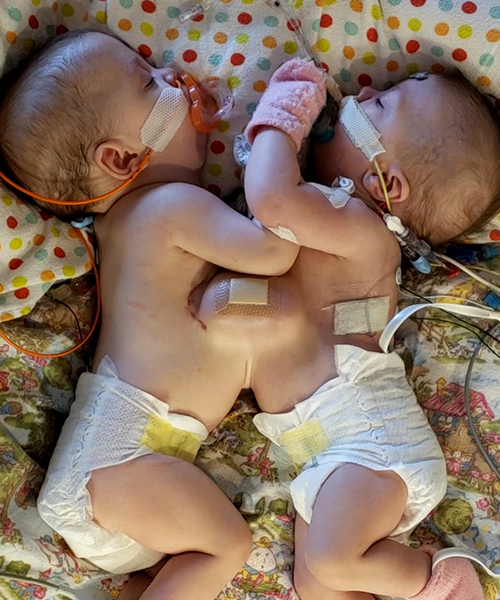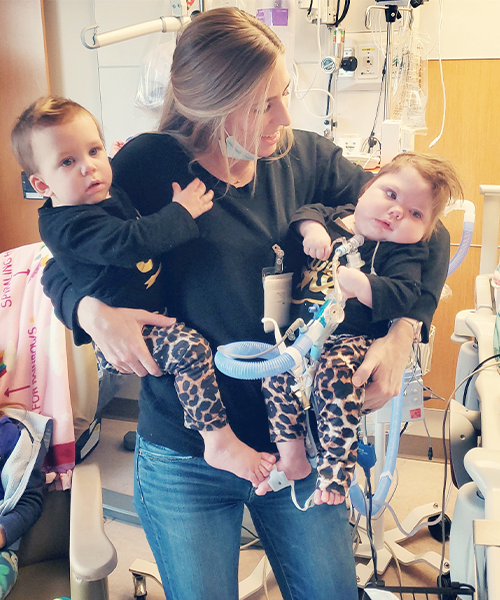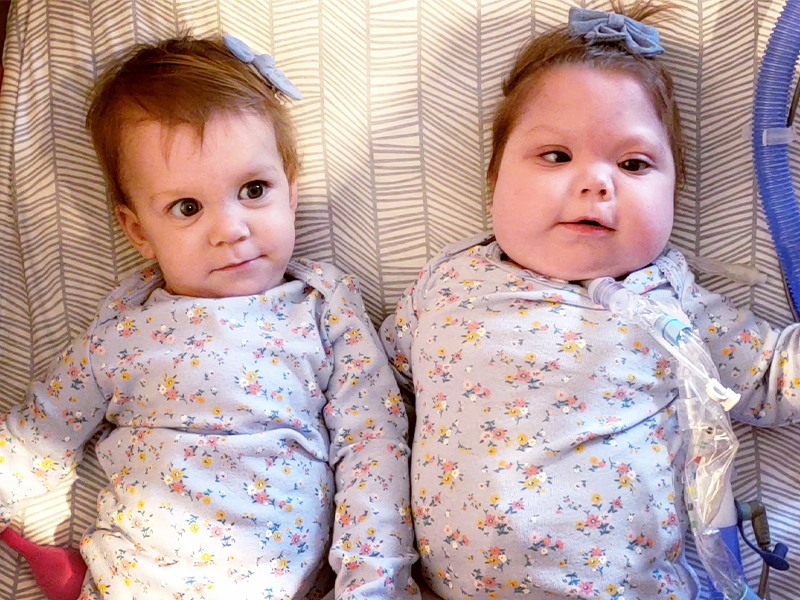Rob and Kate are high school sweethearts who have been married for 10 years and have two other children, Chase and Leana. When they found out they were pregnant for a third time, they were ecstatic! But at their 17-week check-up, their lives changed forever.
Not only twins, but conjoined twins
At their regular 17-week check-up, Rob and Kate were sent to get an ultrasound to make sure everything was OK with their baby. In the ultrasound, the parents couldn’t figure out what they were seeing on the screen. Rob asked, “What are we looking at?” After getting confirmation they were in fact seeing two babies, another thought came to mind: “It looks like they’re conjoined,” said Kate.
They could see that their babies were connected at the belly but weren’t sure about anything else. Questions ran through the parents’ minds: Do they have their own organs? Do they have their own arms and legs?
“It felt so unreal, you don’t hear about this often and never think it could happen to you,” said Kate.
Leading up to the birth of the twins

Having twins was an exciting thought but having conjoined twins scared Kate and Rob. “Pregnancy is supposed to be this magical thing of creating a human life,” Kate said. “Instead we were in constant fear that at any moment it could turn for the worse.”
After learning they were having conjoined twins, Rob and Kate began regular doctors’ appointments at the Midwest Fetal Care Center (MWFCC), a collaboration between Allina Health and Children’s Minnesota that brings together a multi-disciplinary team of maternal, fetal, neonatal and pediatric experts.
It is also the only advanced fetal care center in the Upper Midwest that provides state of the art fetal diagnosis through delivery, like in the case of the Erickson twins.

Dr. Joseph Lillegard, pediatric surgeon at MWFCC and Children’s Minnesota and lead surgeon on Remi and Reese, describes just how rare having conjoined twins is. “Conjoined twins represent about one in every 200,000 live births. That means we see one of these cases in Minnesota once every three years or about 18 times a year in the United States.”
Kate describes this experience, “It was emotionally draining,” she said. “Yet the doctors each week had a way of keeping us looking toward the positives even though they found some new problem at each appointment. They never gave up on us or rushed us out of the door.”
Giving birth to Remi and Reese
On Nov. 22, 2019, Kate gave birth to their conjoined twin daughters, Remi and Reese, both very much alive.
They found out the twins were connected through the chest wall, abdomen and pelvic sections of their bodies and shared a liver. Typical healthy twins have two umbilical cords when they’re born but Remi and Reese shared only one.
“We knew as soon as they were born, they were going to be fighting to survive,” Robert said in an interview with FOX 9.
Throughout the pregnancy, Remi was Reese’s anchor and she continued to be after they were born. “Whatever work Reese wasn’t doing, Remi picked up the slack for her,” Kate described.
After delivery, life continued to be a roller coaster for the family. Reese continued to have problems with her heart, kidney and airways. Talk of when to separate the twins changed constantly due to Reese’s constant complications.
After four-and-a-half months of around-the-clock care and much deliberation, Remi and Reese’s medical team at Children’s Minnesota decided they needed to be separated.
“Each team had to sit down and deliberate which organ could tolerate what and when to make sure it was a safe separation giving her [Reese] the best odds of surviving,” Kate said. “Thankfully, everyone came to a clear plan with multiple back-up options!”
The separation
At this point, the COVID-19 pandemic was in full force, making preparation for the separation surgery even harder on the family emotionally and on the hospital logistically. The medical team and family had to create a plan that made sure the twins were healthy and safe and the parents (and twins) hadn’t contracted COVID-19 before coming to the hospital.
The days leading up to the surgery were intense, described Kate. The medical team prepared the parents with what surgery day would look like, how the surgery would go and any possibilities of what might happen. Because the surgery was so complicated and the outcome wasn’t guaranteed, the team even prepared Kate and Rob on how they would say goodbye to their daughter Reese if she didn’t make it. “It was emotionally grueling,” Kate said.
On April 9, the separation surgery took place and lasted seven hours.
Remi and Reese’s parents received updates throughout surgery. The last update they received: Their daughters were successfully separated and both stable! The large medical team rolled out the twins to see their parents after surgery.

“The mood in the room was absolutely insane. You could feel how proud the team was for this achievement, how proud everyone was of these two tiny little babies who fought so hard,” Kate said. We couldn’t stop smiling or staring, thinking, is this even real life?”
Life after separation
Immediately after separation, the girls were doing incredible. Remi was in a great spot – she did a lot of the work to help keep Reese alive during pregnancy and after birth so, she needed a lot of rest after their separation. Reese surprised everyone with how well she handled such a big surgery. While she would need more help than Remi, she still thrived after their separation.
Remi was discharged from the hospital only about a month later, while Reese had to stay for an additional eight months, through her first birthday.

“We are so amazed to be where we are at today with these little fighters,” Kate said.
Now with both Reese and Remi at home, Kate and Rob couldn’t be happier.
“Although life is hard at home right now and intimidating being solely in charge of her [Reese] without the team of doctors to rely on, we are beyond happy to all be together finally.”
Watching their daughters fight for their lives has been an experience unlike any other and Rob and Kate are so thankful to have the medical team they did at Children’s Minnesota and the Midwest Fetal Care Center.
“After spending a year at Children’s Minnesota, the team in the CVICU (cardiovascular intensive care unit), all the surgeons and all the specialists became our second family. There was never a moment that they let us feel we had no options,” said Kate. “I never had a doubt that the team we had would get us through this with both girls.”
And that’s exactly what they did.